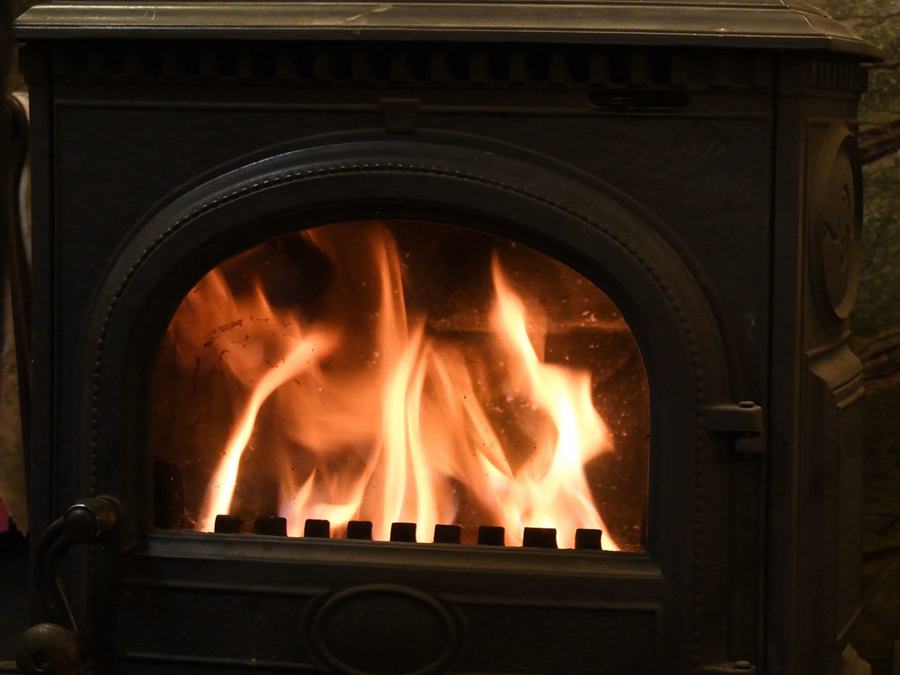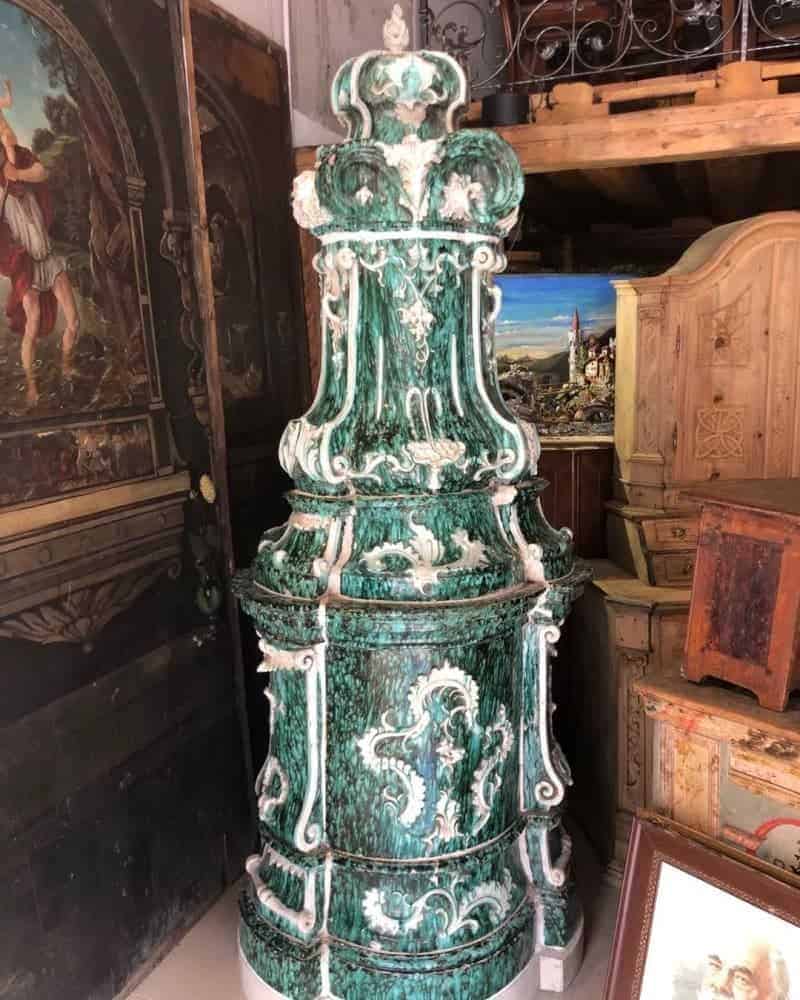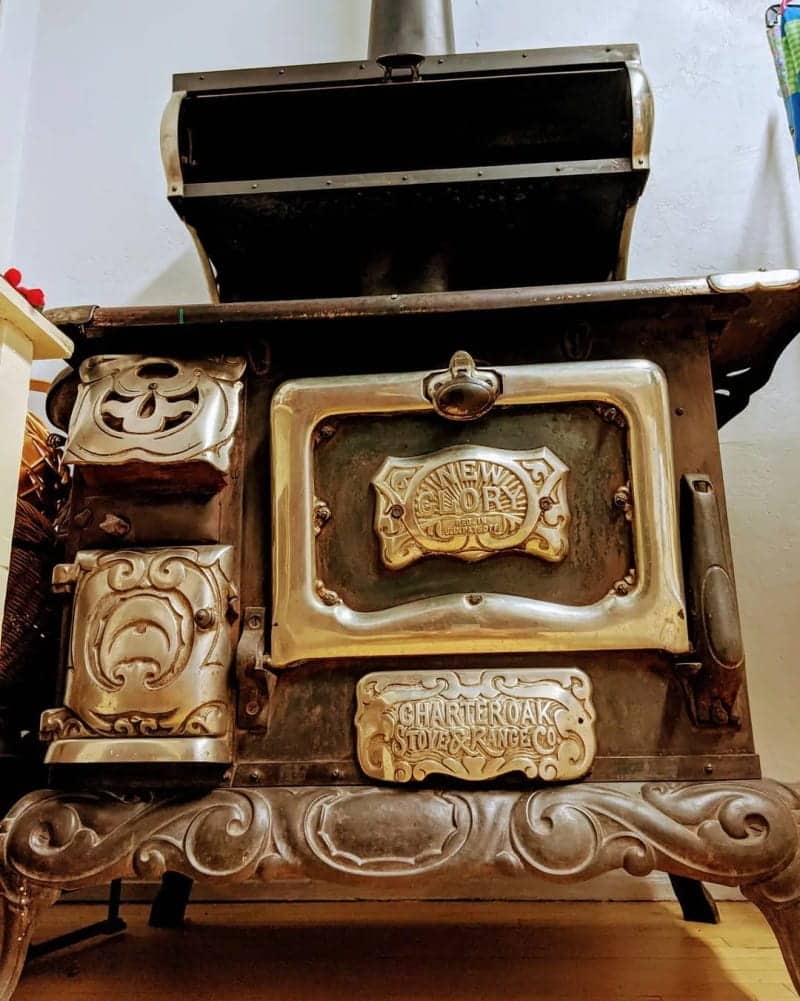Antique wood stoves hold a special place in the hearts of collectors and those who appreciate their timeless beauty and practicality. As you delve into the world of antique wood stoves, you’ll be amazed by the craftsmanship of these utilitarian objects that have evolved for over 200 years. In this guide, you’ll learn how to identify and value these unique appliances that once served a dual purpose – providing warmth to homes and serving as a centerpiece for family gatherings.
Identification of antique wood stoves involves examining their distinct features and characteristics. There are four primary types of antique wood stoves: kitchen stoves, parlor stoves, box stoves, and cylinder stoves. Each type has its attributes and value, determined by factors such as age, rarity, condition, and manufacturer. By understanding these different types and their identifying features, you’ll be well on your way to uncovering the history and value of your antique wood stove.
Accurately valuing antique wood stoves is crucial in determining their worth in the market. Prices can range from a few hundred dollars for common models to several thousand dollars for rare and intricate pieces. Your search for value will entail looking up patent numbers on the United States Patent Office website, assessing the condition of your wood stove, and comparing it to similar stoves that have recently sold. Armed with this knowledge, you can confidently navigate the bustling world of antique wood stove collecting, and possibly discover a hidden treasure among the ashes.
Table of Contents
History of Antique Wood Stoves
Evolution of Design
In the 18th century, people were using open fires for cooking and heating. By the early 1700s, cast iron stoves were introduced, which were used not only for heating purposes but also for cooking and doing laundry. Over time, design elements evolved to make these stoves more efficient and aesthetically pleasing.
Victorian Era Stoves
During the Victorian era, wood stoves developed more intricate designs and ornamentation. As a result, your Victorian wood stove may have more details and accents, such as embossed patterns, filigree, or even porcelain enameled surfaces. With this increased refinement, wood stoves gained popularity not only for their function but also as a piece of furniture that added character to the room.
Franklin Stoves
Franklin stoves were designed by Benjamin Franklin in the 1700s. These antique wood stoves are seldom used today due to safety concerns. You can identify a Franklin stove by its fireplace insert-like design, often featuring hinged doors for adding wood. Although not commonly found in homes today, their historical significance makes them an interesting piece for wood stove collectors.
Parlor Stoves
Parlor stoves were a popular choice for heating living spaces in the late 1800s and early 1900s. These stoves were designed to not only provide warmth but also to be aesthetically pleasing as they typically served as a focal point in a room. Key features of these stoves include intricate cast iron designs and various decorative elements.
Cast Iron Stoves
The majority of antique wood stoves were made of cast iron due to its ability to retain and radiate heat efficiently. Your cast iron stove will typically have a cubical body, an enclosed fire chamber, and a chimney. It might also have additional features such as shelves, ledges, or carved shutters and legs which can increase its value by 3 – 4%.
Remember that when identifying and valuing your antique wood stove, factors such as age, design, and historical significance play a significant role.
6 Types of Antique Wood Stoves
Box Style
Box style stoves are a classic type of antique wood stove. These stoves are typically made of cast iron and designed with simplistic square or rectangular shapes. They usually provide a large flat surface on top for heating or cooking purposes. Some popular brands for antique box-style wood stoves are Charter Oak Stove Company and other vintage wood stove manufacturers.
Pot-Bellied Stoves
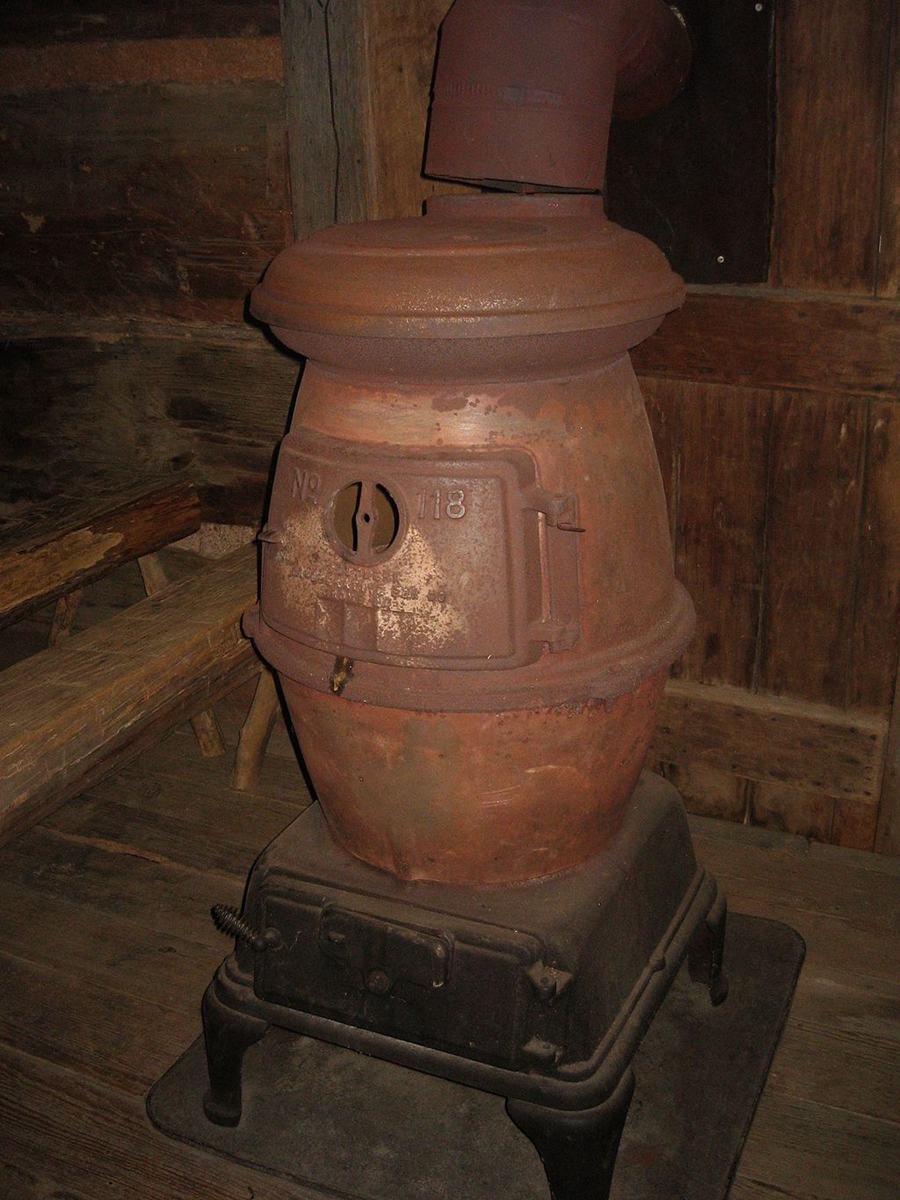
Pot-bellied stoves are a unique and popular type of vintage wood stove. As their name implies, they have a round, bulging shape resembling a potbelly. They were commonly used in the 19th and early 20th centuries for heating homes, businesses, and even train cars. They offer an efficient and charming heating source that often doubles as a small cooking area on the top.
Soapstone Wood Stoves
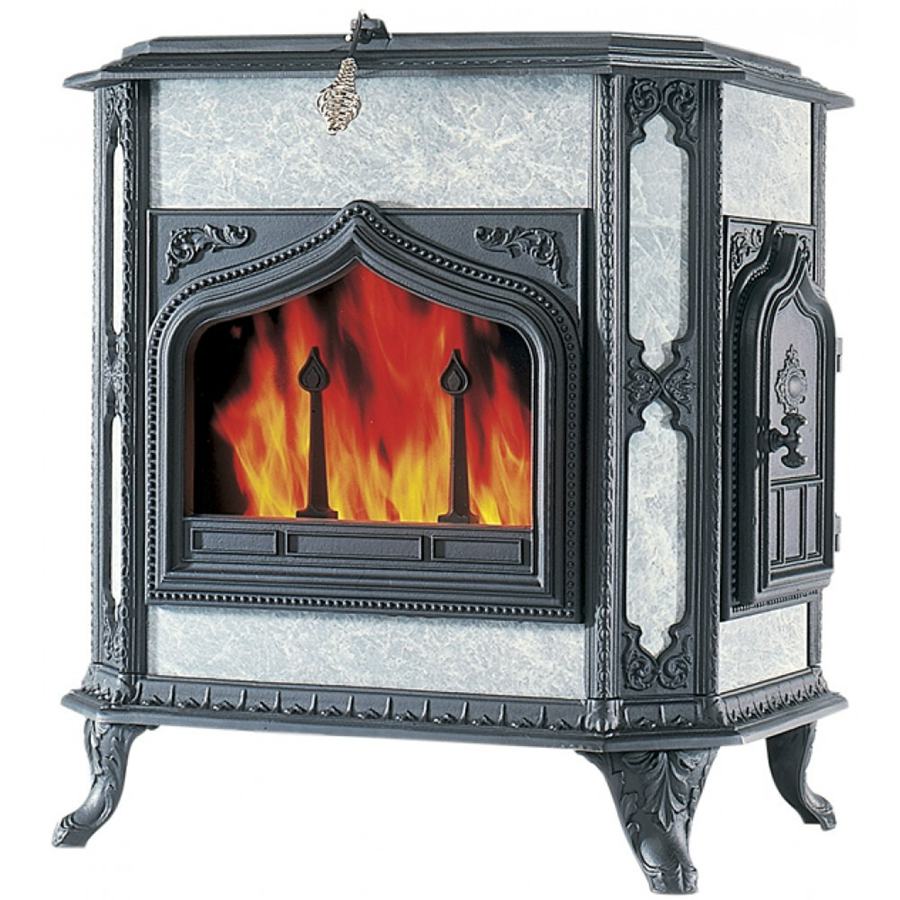
Soapstone wood stoves have a unique composition. The soapstone material retains and radiates heat for a longer period, making them energy efficient. These stoves usually have a more intricate design with detailed patterns, carved on the soapstone panels. They are highly sought after for their distinct appearance and function.
Ceramic Wood Stoves
Ceramic wood stoves are another type of antique stove that use ceramic tiles in their construction. They often have elaborately decorated tiles and create a beautiful focal point in any room. Ceramic wood stoves are not only visually appealing but provide great insulation and heat retention.
Eisenglass Stoves
Eisenglass stoves are made of cast iron and incorporate a unique feature: transparent mica windows, known as eisenglass. These windows allow you to view the flames inside the stove while it’s in operation. This makes them highly desirable for their aesthetic appeal and practical function.
Victorian Cast Iron Parlor Stove
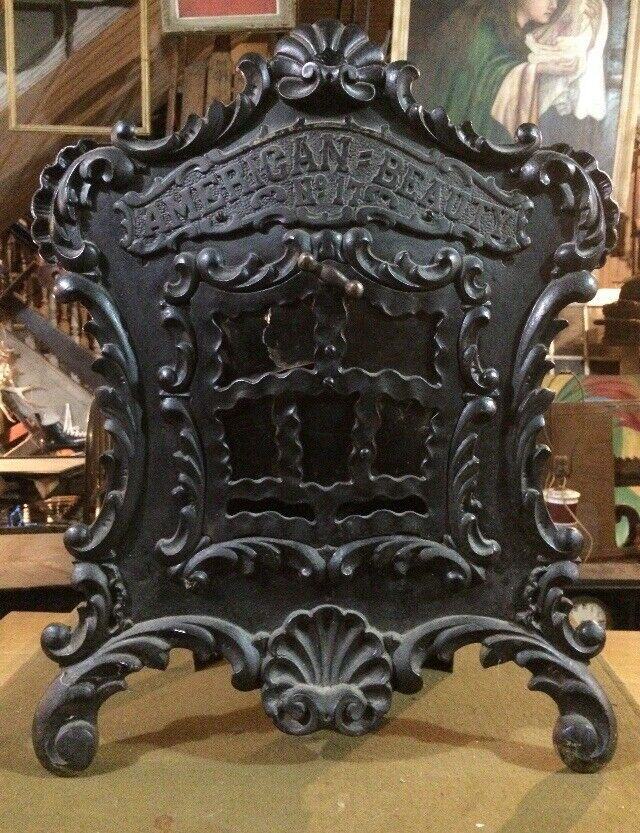
Victorian cast iron parlor stoves were a highly ornate type of antique wood-burning stove. They were commonly used in the 19th century and often featured intricate designs, elegant decorative elements, and polished finishes. These stoves, with their refined appearance, were a symbol of status and affluence during the Victorian era.
Each of these types of antique wood stoves offers unique characteristics and values. To determine the value of your antique stove, consider factors such as age, condition, rarity, and demand for that particular type of stove. By identifying and appreciating these various types of stoves, you can better assess the value and historical significance of your own antique wood stove.
9 Factors to Identify & Value an Antique Wood Stove
1. Age
As you dive into the world of antique wood stoves, knowing the age of your stove is an essential factor in determining its value. It can help you differentiate between a truly antique piece and a reproduction. To do this, pay attention to the following details:
Materials Used: Early wood stoves were typically made of cast iron. If you notice steel elements, it might indicate a later production.
Manufacturing Techniques: Look for signs of old manufacturing techniques like hand-forging. For example, if you find rough surfaces and irregular angles instead of smooth surfaces, older methods may have been used.
Here is a valuation table based on the age of the antique wood stove:
| Age | Average Valuation |
|---|---|
| Pre-1700 | $5,000 – 6,000 |
| 1700s | $3,000 – 4,500 |
| 1800s | $2,000 – 3,000 |
| Early 1900s | $1,000 – 2,000 |
| Mid-1900s | $500 – 1,000 |
Design Elements: Analyze the stove’s decoration and design styles. Early wood stoves feature intricate and ornate designs, while later models have simpler and more functional styles. Additionally, older stoves usually have legs, giving them an elevated appearance.
Branding and Markings: Inspect the stove for any brand markings or stamps. Some manufacturers placed their logo on the stove, while others used numbers or letters to indicate the model or year of production. Researching these markings will help you to identify the stove’s age, origin, and possible value.
Bear in mind that different factors play a role in the valuation of your antique wood stove, and the table provided is just a general guide. For a more precise evaluation, consult an experienced antique appraiser or dealer familiar with wood stoves.
2. Brand
When it comes to identifying antique wood stoves, paying attention to the brand can be crucial in determining their value. There were several popular brands that manufactured antique wood stoves, each with their unique characteristics and value in the market. Some of the well-known brand names you might come across include Queen Atlantic, Glenwood, Clarion, Charter Oak Stove Company, and Home Comfort.
To help you get a better understanding of the valuation process, here is a table with the average valuation of wood stoves based on their brand:
| Brand | Average Valuation |
|---|---|
| Queen Atlantic | $450 – $600 |
| Glenwood | $400 – $550 |
| Clarion | $350 – $500 |
| Charter Oak Stove Company | $500 – $700 |
| Home Comfort | $400 – $550 |
Please note that these valuations are approximate and can vary greatly depending on factors such as the stove’s age, rarity, condition, and desirability. Additionally, patent numbers can be found on many old wood stoves, particularly cast iron ones. Identification patent numbers can provide further insight into the stove’s origins and help you verify if it is indeed a genuine piece.
It is essential to research each brand individually to understand their specific features, the time period they were manufactured, and the demand for their products. This will not only help you identify the brand of your antique wood stove but also give you a clearer idea of the value it holds. Remember that multiple factors play a role in determining the value of a wood stove, and researching thoroughly will ensure you make an accurate assessment.
3. Patent Numbers
When identifying antique wood stoves, one of the main pieces of information you may need to consider is the patent number. Patent numbers hold important information on the legitimacy, age, and the original manufacturer of a stove. In this section, we’ll provide you with some guidance on identifying patent numbers for antique wood stoves.
First, let’s take a look at where you can find these numbers. Examine your antique wood stove closely to see if there are any inscriptions, engravings or markings on it. Patent numbers are typically found on the back or side of the stove, in a well-visible area, or sometimes stamped onto moving parts, such as the bi-fold doors.
Once you find the patent number, use a table like the following to help you determine the value:
| Factor Influencing Value | Average Valuation | Note(s) |
|---|---|---|
| Original Manufacturer | $100 – $350 | Patent numbers can help you identify manufacturers. |
| Age of Stove | $50 – $500 | Older stoves may have higher values, but also consider condition. |
| Rarity of Model | $300 – $700 | Less commonly found models may be more valuable. |
| Design & Craftsmanship | $150 – $450 | Unique design features or high-quality craftsmanship can increase value. |
| Condition of Stove | $100 – $300 | A pristine condition stove is more valuable than one in poor condition. |
Keep in mind that these valuations are approximate and can vary based on several factors such as market demand, rarity, and regional differences.
When researching the patent number, it’s essential to check reputable sources for accurate information. Online patent databases and reference books, such as collector’s guides and auction catalogs, can help you gain a better understanding of the antique wood stoves market and better gauge the value of your piece.
As you proceed with your research, be prepared to encounter discrepancies or conflicting information. This is not uncommon in the world of antiques. Approach such situations with a discerning mindset, and base your judgement on multiple reputable sources.
4. Material
Antique wood stoves were typically made from a combination of cast iron and steel. The stoves usually have a cubical or cylindrical body with an enclosed fire chamber and a chimney. Some rarer models may feature shelves, ledges, or carved shutters and legs, which can increase their valuation.
Here is a list of key materials and features that can affect the valuation of an antique wood stove:
- Cast Iron Body: Most antique wood stoves are made of cast iron, which is known for its durability and excellent heat retention properties. A well-maintained cast iron stove can fetch higher value.
- Steel Body: Some stoves feature a steel body instead of cast iron, which might result in a lower valuation due to its inferior heat retention compared to cast iron.
- Wooden Parts: Antique stoves may have a mix of wood and metal parts, signaling a higher value as they showcase older craftsmanship.
- Eisenglass: This compressed mica material was used for window panels in antique wood stoves. Finding a stove with intact eisenglass can increase its value, as it tends to flake and discolor over time.
- Ornamental Features: Intricate detailing and decorative elements on the stove can elevate its worth considerably.
Here’s a valuation table based on the stoves’ material and additional features:
| Material & Features | Average Valuation |
|---|---|
| Cast Iron Body | $500 – 600 |
| Steel Body | $400 – 450 |
| Wooden Parts | $450 – 500 |
| Intact Eisenglass Windows | $550 – 600 |
| Ornamental Features, Carvings, or Detail | $600 – 700 |
Keep in mind that these valuations are estimates and can vary greatly depending on the specific model, condition, and rarity of the stove. It’s always best to consult with an antique appraiser or specialist when attempting to accurately determine the value of your antique wood stove.
5. Size
When valuing antique wood stoves, the size of the stove plays an important role in determining its worth. Larger pieces may be more valuable, as they often consist of more intricate designs and have more heating capacity. However, smaller stoves may also be desirable due to their portability and ease of installation in modern homes. Here are some key considerations regarding antique wood stoves size.
Physical Dimensions
Antique wood stoves come in a variety of sizes, which impacts their value. For example, a larger stove may command a higher price due to its more robust heat output or additional cooking surfaces. The table below displays an approximate valuation range for stoves based on their dimensions.
| Dimensions (in inches) | Average Valuation |
|---|---|
| 24″ x 24″ x 24″ | $300 – 400 |
| 30″ x 30″ x 30″ | $450 – 500 |
| 36″ x 36″ x 36″ | $600 – 700 |
| 42″ x 42″ x 42″ | $800 – 900 |
Cooking Capabilities
The functionality of antique wood stoves impacts their value as well, with stoves able to handle a variety of tasks fetching higher prices. The following table outlines some common cooking features and their associated valuations.
| Cooking Feature | Average Valuation |
|---|---|
| Single Burner | $200 – 300 |
| Multiple Burners | $400 – 500 |
| Burners and Oven | $600 – 700 |
| Double Ovens | $800 – 900 |
Weight
The weight of an antique wood stove is another factor to consider. Sturdier stoves made from more substantial materials may be more valuable due to their longevity and durability. Here’s a valuation table based on the weight of antique wood stoves.
| Weight (in pounds) | Average Valuation |
|---|---|
| 50 – 100 lbs | $200 – 300 |
| 100 – 200 lbs | $350 – 450 |
| 200 – 300 lbs | $500 – 600 |
| 300 – 400 lbs | $650 – 750 |
Remember that these are only approximate guidelines and the actual value of your antique wood stove may vary according to market demand, scarcity, and other factors. Consult additional sources and experts to establish a more accurate valuation for your specific stove.
6. Functionality
When evaluating antique wood stoves, one of the key factors to consider is their functionality. A fully functional antique wood stove not only adds to its value but also serves as a conversation piece and a unique heating source for your home. In this section, we will discuss how to assess the functionality of an antique wood stove and provide you with a valuation table for various factors related to functionality.
1. Chimney and Firebox Condition
The condition of the chimney and firebox is crucial in determining the functionality of a wood stove. Examine the chimney for any cracks, breaks, or signs of wear. Check the firebox for signs of excessive rust or damage. A wood stove with a well-maintained chimney and firebox will be more valuable than one with issues in these areas.
| Chimney & Firebox Condition | Average Valuation |
|---|---|
| Excellent | $600 – $700 |
| Good | $500 – $600 |
| Fair | $400 – $500 |
| Poor | $300 – $400 |
2. Manufacturer and Model
The manufacturer and model of the antique wood stove can play a significant role in determining its value. Some manufacturers are more sought after by collectors, while specific models may be harder to come by.
| Manufacturer & Model | Average Valuation |
|---|---|
| Rare Manufacturer/Model | $800 – $1,000 |
| Popular Manufacturer | $600 – $800 |
| Common Manufacturer | $400 – $600 |
3. Ease of Restoration
If you intend to restore the antique wood stove to working condition, consider the ease of restoration. Examine the availability of spare parts and the overall complexity of the restoration process. A wood stove that is easier to restore will generally be more valuable.
| Ease of Restoration | Average Valuation |
|---|---|
| Easy | $700 – $800 |
| Moderate | $500 – $700 |
| Difficult | $300 – $500 |
Keep these factors in mind as you assess the functionality of your antique wood stove. By considering the condition of the chimney and firebox, the manufacturer and model, and the ease of restoration, you can make an informed decision about the value of your antique wood stove.
7. Condition
When assessing the value of an antique wood stove, one of the critical factors to consider is its condition. The condition of a wood stove can significantly impact its value, with well-preserved stoves being worth more than those with visible damages or missing parts.
When evaluating the condition of your antique wood stove, it’s essential to consider factors such as:
- Presence of any cracks or damage to the cast iron or steel body
- Any sign of rust on the stove’s metal parts
- Integrity of the fire chamber and chimney
- Damages to any unique features like shelves, ledges, or legs
Here is a valuation table for antique wood stoves based on condition:
| Condition | Average Valuation |
|---|---|
| Excellent (no cracks, rust, or missing parts) | $2,500 – $3,000 |
| Good (minor damage, small rust spots) | $1,000 – $2,000 |
| Fair (visible damage, rusted parts) | $500 – $1,000 |
| Poor (significant damage, missing parts) | $100 – $500 |
Keep in mind that these values can vary depending on several factors such as the rarity of the stove, its age, and the demand for the specific wood stove model. It’s also essential to remember that a well-maintained wood stove will likely be more valuable than a poorly-maintained one, so consider the stove’s upkeep history when determining its value. Mark down any adjustments you make to the stove for repairs or maintenance, as this can affect its value.
Determining the appropriate value of an antique wood stove can be challenging, but with careful attention to detail and consideration of the various factors that can affect its value, you can confidently estimate its worth.
8. Rarity
When it comes to antique wood stoves, rarity plays a significant role in determining their value. This section will provide information on the factors that affect the rarity and subsequent value of the stoves. Also, we present valuation tables for each factor to help provide an estimation of these stoves’ worth.
It’s important to note that rare models often have higher values, but rarity alone doesn’t necessarily mean that the antique stove is more valuable. Condition, design, age, and overall appeal also contribute to a stove’s value.
Valuation Table Based on Type
The first factor that can affect their value is the type of antique wood stove. Here’s a table providing average valuations based on different types or designs:
| Type of Antique Wood Stove | Average Valuation |
|---|---|
| Franklin Wood Stoves (1700s) | $1,000 – $1,500 |
| Victor Enamel Cook Stove | $1,000 – $1,250 |
| Ornate Victorian Cast Iron Parlor Stove | $300 – $600 |
| Civil War Era Small Wood Heating Stove | $200 – $350 |
| Vintage Enamel Cook Stove | $500 – $1,000 |
Valuation Table Based on Condition
The next factor to consider is the condition of the antique wood stove. The overall value will increase if the stove is in pristine or excellent condition. Below is the valuation table for various conditions:
| Condition of Antique Wood Stove | Average Valuation |
|---|---|
| Pristine / Restored | +30% – 50% of Base Value |
| Good / Minor Restoration Needed | +10% – 20% of Base Value |
| Fair / Significant Restoration Needed | -10% – 20% of Base Value |
| Poor / Major Restoration Needed | -30% – 50% of Base Value |
Remember that accurately determining the condition of an antique wood stove requires expertise and knowledge. Seek professional help if you’re unsure of the stove’s condition.
It’s evident that the rarity of antique wood stoves can be influenced by various factors. Assessing these factors will help you understand your wood stove’s value better. However, keep in mind that the valuations presented in the tables above are estimates, and the actual value may vary based on various factors, including regional differences and buyer preferences.
9. Historical Significance
Antique wood stoves have played an important role in history, serving as essential appliances in households during the 1800s and early 1900s. These stoves offered not only warmth but also a means for cooking and even laundering clothes. As such, they hold a special place in our historical heritage.
There were several styles of antique wood stoves, including Victorian, parlor, and box-style designs that featured intricate cast iron or steel construction. As a collector or enthusiast, understanding the historical significance of these stoves is essential in appreciating their value.
Factors that affect the value of antique wood stoves include their design, rarity, and condition. The table below provides an example of the average valuation based on specific characteristics:
| Antique Wood Stove Style | Average Valuation |
|---|---|
| Victorian Style | $1000 – $1500 |
| Parlor Style | $750 – $1000 |
| Box Style | $600 – $900 |
| Unusual or Rare Design | Varies (up to $3000+) |
Keep in mind that the above valuations are just an example and can vary greatly depending on the specific stove and its condition.
When evaluating the historical significance and value of an antique wood stove, consider its era, craftsmanship, and any unique features that may make it more desirable. Additionally, well-preserved antique wood stoves in working condition may fetch higher prices.
In summary, appreciating the historical significance of antique wood stoves is crucial to understanding their value. By evaluating the design, rarity, and condition of these historical appliances, you can gain a better understanding of their worth and importance in the context of our shared cultural heritage.
Buying and Selling Tips
Where to Find Antique Wood Stoves
When searching for antique wood stoves, you can find them in various places such as:
- Estate sales
- Flea markets
- Online marketplaces like eBay and Etsy
- Local antique shops
- Garage sales
Always make sure to ask the seller about the stove’s history and background to get a better understanding of its origin and use.
Authenticating Antique Wood Stoves
Before purchasing an antique wood stove, you should verify its authenticity. This can be done by:
- Examining the manufacturer’s mark on the stove to identify its origin and age.
- Looking for patent numbers engraved on the stove. Antique cast iron stoves typically have a set of numbers starting with ‘PAT’ on their surface. You can use these numbers to look up the invention’s patent on the United States Patent Office database, which will provide you with more information about its age and origin.
- Assessing the stove’s condition and appearance, including its legs’ design, the presence of wooden elements, and overall craftsmanship.
Remember that the stove’s age and condition can significantly impact its value. Generally, antique wood stoves can range from $100 to upwards of $1,000, depending on factors such as rarity and desirability.
Negotiating
When buying or selling an antique wood stove, you should be prepared to negotiate the price. Here are some tips to help you:
- Educate yourself about the stove’s history, features, and value to have a better understanding of the item and its worth.
- Be attentive to the stove’s condition, as this can influence its value.
- Consider the seller’s asking price and compare it to similar items available for sale.
- Be prepared to walk away if the price is too high or if the stove’s authenticity comes into question.
By keeping these buying and selling tips in mind, you can improve your chances of finding a genuine antique wood stove at a fair price.
Final Thoughts
As you navigate the world of antique wood stoves, keep in mind the unique features that help identify different types and add value. Pay attention to the elements like the materials used, design, and specific characteristics such as shelves, ledges, and carved shutters.
To better understand the value, consider factors like rarity, age, and condition. Remember, some antique wood stoves can range from $300 to $1,250 depending on these aspects. Don’t hesitate to consult reliable resources like LoveToKnow, Noname Antiques, or RareAntiqueStoves for more insight into antique stove identification and valuation.
Additionally, make note of any historical significance, such as a connection to a specific time period like the Civil War or a particular craftsman. This can significantly influence the value of your antique stove.
If you decide to use your antique wood stove, ensure that it is professionally installed to maintain its value and for safety reasons. Finally, immerse yourself in the world of antique wood stoves by attending shows and connecting with other collectors and experts in the field. This will not only boost your knowledge but also enhance your appreciation for these time-honored pieces.
Frequently Asked Questions
What are the common types of antique wood stoves?
There are several types of antique wood stoves, including:
- Franklin stoves: Designed by Benjamin Franklin in the 1700s and similar to a fireplace insert.
- Flat top stoves: These stoves have a flat surface on the top for cooking.
- Box stoves: Also known as parlor stoves, these feature decorative elements and were often used in living rooms or parlors.
How can I identify the type and brand of my antique wood stove?
To determine the type of wood stove you have, you can:
- Look for features such as flat top surfaces, hinged doors, or decorative elements.
- Check for the stove brand name, which is often embossed on the stove door or metal parts. Some popular brands include Charter Oak Stove Company, Glenwood, and Queen Atlantic.
What factors affect the value of an antique wood stove?
The value of an antique wood stove can be influenced by:
- Condition: Stoves in good condition with minimal damage are typically more valuable.
- Rarity: Rare models or brands may fetch higher prices.
- Completeness: A stove with all its original parts intact will be worth more.
- Age: Older stoves generally hold more value.
Where can I find information on the value of my antique wood stove?
You may consult online resources, such as antique collector forums, antique stove identification guides, or visit local antique dealers who can help you determine the value of your antique wood stove.
Are antique wood stoves safe to use?
Some antique stoves, like the Franklin stove, may not be safe for modern use due to safety concerns. If you are considering using your antique stove, consult with a professional to ensure it meets current safety standards and is properly installed.

